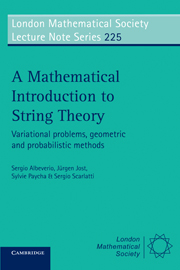 A Mathematical Introduction to String Theory
A Mathematical Introduction to String Theory Book contents
- Frontmatter
- Contents
- Preface
- Dedication
- I.0 Introduction
- Acknowledgements
- I.1 The two-dimensional Plateau problem
- I.2 Topological and metric structures on the space of mappings and metrics
- I.3 Harmonic maps and global structures
- I.4 Cauchy–Riemann operators
- I.5 Zeta-function and heat-kernel determinants of an operator
- I.6 The Faddeev–Popov procedure
- I.7 Determinant bundles
- I.8 Chern classes of determinant bundles
- I.9 Gaussian measures and random fields
- I.10 Functional quantization of the Høegh-Krohn and Liouville models on a compact surface
- I.11 Small time asymptotics for heat-kernel regularized determinants
- II.1 Quantization by functional integrals
- II.2 The Polyakov measure
- II.3 Formal Lebesgue measures on Hilbert spaces
- II.4 The Gaussian integration on the space of embeddings
- II.5 The Faddeev–Popov procedure for bosonic strings
- II.6 The Polyakov measure in noncritical dimension and the Liouville measure
- II.7 The Polyakov measure in the critical dimension d=26
- II.8 Correlation functions
- References
- Index
II.7 - The Polyakov measure in the critical dimension d=26
Published online by Cambridge University Press: 01 June 2011
- Frontmatter
- Contents
- Preface
- Dedication
- I.0 Introduction
- Acknowledgements
- I.1 The two-dimensional Plateau problem
- I.2 Topological and metric structures on the space of mappings and metrics
- I.3 Harmonic maps and global structures
- I.4 Cauchy–Riemann operators
- I.5 Zeta-function and heat-kernel determinants of an operator
- I.6 The Faddeev–Popov procedure
- I.7 Determinant bundles
- I.8 Chern classes of determinant bundles
- I.9 Gaussian measures and random fields
- I.10 Functional quantization of the Høegh-Krohn and Liouville models on a compact surface
- I.11 Small time asymptotics for heat-kernel regularized determinants
- II.1 Quantization by functional integrals
- II.2 The Polyakov measure
- II.3 Formal Lebesgue measures on Hilbert spaces
- II.4 The Gaussian integration on the space of embeddings
- II.5 The Faddeev–Popov procedure for bosonic strings
- II.6 The Polyakov measure in noncritical dimension and the Liouville measure
- II.7 The Polyakov measure in the critical dimension d=26
- II.8 Correlation functions
- References
- Index
Summary
We recall that in section II.4 we replaced the integration over the embeddings X by the determinant of the Laplace operator, and that in section II.5 we implemented the Faddeev–Popov procedure to discard the integration over D0 (the group of smooth diffeomorphisms homotopic to the identity) by introducing the Faddeev–Popov determinant, which essentially coincides with the determinant of the operator Pg given by (1.4.10). In section II.6, we interpreted the integration over the conformal deformations in terms of a family of Liouville measures indexed by Teichmüller parameters. In this section we shall investigate the integration over Teichmüller space; the measure on the latter is given by the Weil–Petersson metric. There are many articles concerning a “direct” description of the Polyakov measure in critical dimension, e.g. [BJ], [BK], [BM], but these do not discuss, as we did, its derivation from functional integrals considered for all d.
As before, we let Tp,k be the Teichmüller space of surfaces of genus p with k boundaries. As discussed in section 1.7, it can be considered as a totally real subspace of Tq, with q = 2p + k − 1, the genus of the Schottky double. We recall that the cotangent space of Tp,k is given by the holomorphic quadratic differentials which are real on the boundary, and that on this space we have the Weil–Petersson metric. Complexifying, we obtain the space of holomorphic quadratic differentials on closed surfaces of genus q, and these differentials vary holomorphically with the conformal structure of the surface.
Information
- Type
- Chapter
- Information
- A Mathematical Introduction to String TheoryVariational Problems, Geometric and Probabilistic Methods, pp. 117 - 121Publisher: Cambridge University PressPrint publication year: 1997